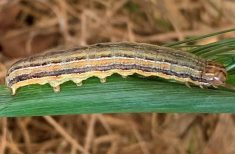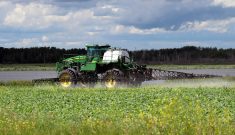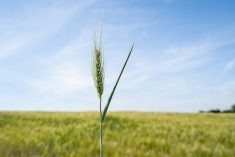It’s still the middle of winter, but it’s never too early to think about grasshoppers.
That was one message delivered at last month’s Canola Week annual meetings in Calgary, which brought together canola industry leaders from across North America.
Meghan Vankosky, a field crop entomologist with Agriculture and Agri-Food Canada based in Saskatoon, spoke during a crop update panel.
Read Also

Cancer agency reclassifies another herbicide ‘probably carcinogenic’
The WHO’s cancer research agency has now put atrazine, a herbicide well known to corn growers, in the same potential-hazard category where the agency put glyphosate.
She said the number of areas in the Prairies with higher grasshopper populations has been increasing in recent years. That was especially true in 2023 in southern regions of Alberta and Saskatchewan, and to a less extent parts of Manitoba.
Head start
Vankosky, who is also co-chair of the Prairie Pest Monitoring Network, said grasshoppers got off to a “great head start” last spring because of the hot, dry conditions that blanketed large sections of the Prairie provinces.
“We usually start going out to selected sites in Saskatchewan during that first week of May with our summer students because we want to get zeros. We want to know there are no grasshopper nymphs yet,” she said.
“Well, there were already grasshopper nymphs the first week of May. We had grasshopper development almost two weeks ahead of normal in 2023 because of that hot start in May.
“That meant that by June 15, we had adult pest grasshoppers on the Prairies. That has not happened in over 35 years. I work with people who have been working on grasshoppers their entire careers… and they’ve never seen adult grasshoppers in June. That’s not good.”
The situation was so bad in parts of southwestern Saskatchewan that some rural municipalities were “disaster zones” where grasshopper damage combined with the effects of drought and losses from ground squirrels.
Though grasshoppers don’t normally prefer canola, they make an exception when conditions are dry and they are desperate for food, Vankosky said.
The grasshopper situation in 2024 will largely depend on weather, she said. If it stays warm and dry again, as it has in the past few years, “2024 is looking to be unfortunately even worse than 2023 in terms of grasshoppers.”
Be ready
She advises producers to scout early and often.
“Grasshoppers are easiest to kill when they’re small because they can’t get away from the insecticides and it takes less of the insecticide to kill. You can treat the ditches or the field edges before they move into the field and you then have to spray the whole field.”
Vankosky also advised farmers to check provincial and regional pest maps when they are released and watch the web for the latest information provided by provincial officials and the Prairie Pest Monitoring Network.
Taking note
Dan Johnson, a professor of environmental science at the University of Lethbridge and a former specialist with AAFC, spoke about what he referred to as “the re-emerging grasshopper problem” during a panel about insect management tools.
He said it’s important to note what kinds of grasshoppers are present to determine how much damage they could potentially cause and how best to limit it.
There are about 80 species of grasshoppers in Western Canada, but only a handful are considered crop pests.

The two-striped grasshopper is a notorious “gobbler” of most crops, including canola. It feeds on canola pods, causing serious damage, and can even clip them right off a plant. It has two pale stripes that extend from its eyes to the tips of its forewings and solid black stripes on its hind legs.
Johnson said the two-striped variety can be difficult to identify because they change colour during the season. They are normally tan after hatching before becoming green, purple, orange or yellow soon after.
The Packard’s grasshopper and Bruner’s spur-throated grasshopper are two other troublesome species in canola and other broadleaf crops. The young Packard’s is green with black scattered dots that resemble pepper, and the adult version is grey to dark yellow with two light-coloured stripes behind the eyes with grey forewings.
The Bruner’s grasshopper is pale to dark brown with a hind tibia that is usually pink or red. It is more common in foothills and northern regions, although it’s also an issue in a few southern areas such as the Cypress Hills region in Alberta.

Clear-winged grasshoppers aren’t much of a threat to canola since they prefer to feed on grass and cereal crops, Johnson said. They are yellowish or brownish with clear wings adorned with dark patches.
Any grasshopper with hind wings that are highly visible in flight (red, yellow, orange or black) or that sing or clack, are not pests.
Johnson noted thresholds don’t really matter when it comes to grasshoppers.
“This is not an insect that thresholds apply to very well. Look for damage,” he said.
Fewer tools available
He also told growers that fewer tools will be available to fight grasshoppers this season.
Health Canada’s Pest Management Regulatory Agency determined last year that lambda-cyhalothrin products such as Matador and Silencer will not be available for use on crops destined for livestock feed, which effectively means they can no longer be used for any grain, oilseed or pulse crop grown in Western Canada.
There are some biological controls, which Johnson said offer “some pretty good control” but they may take time to work.
Weather data from the 1950s to the present shows average temperatures trending upward, which doesn’t bode well for future grasshopper populations, said Johnson.
“We might have to get used to grasshoppers because they benefit from that (rise in temperatures).”
















